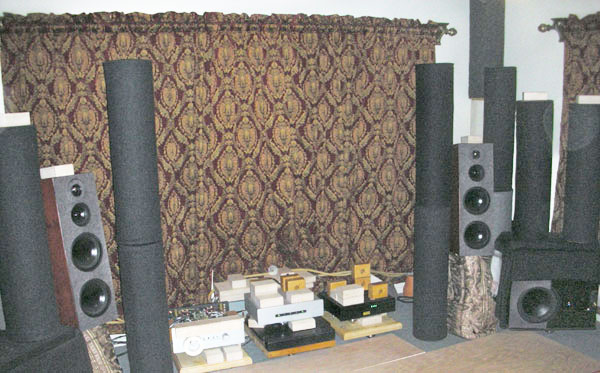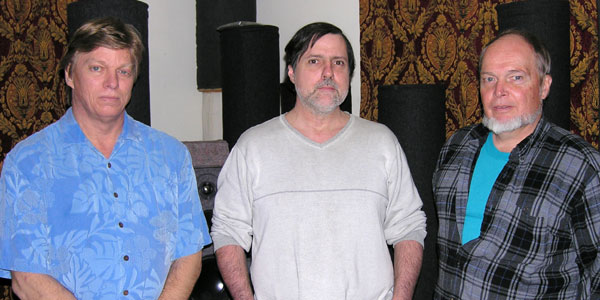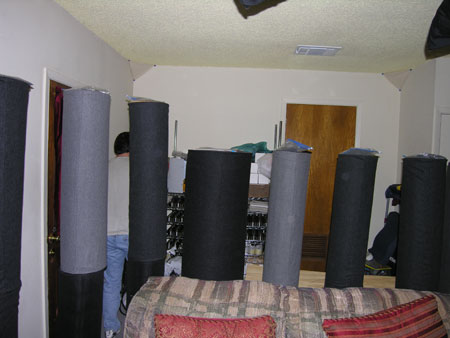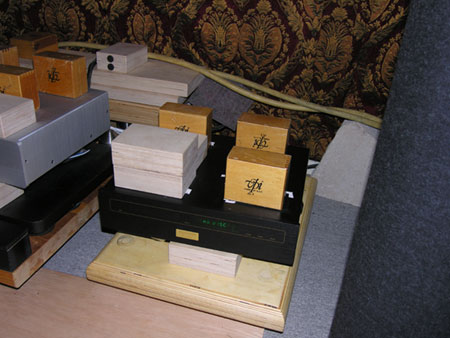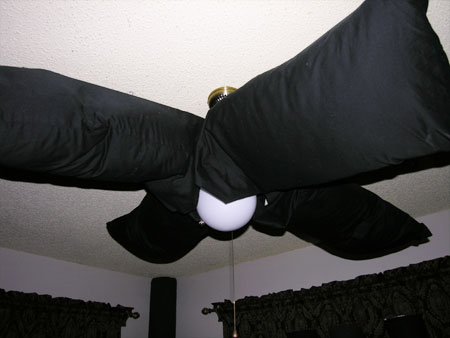![[SoundStage!]](../sslogo3.gif) Config.Sys Config.SysBack-Issue Article |
|||
May 2007 Austin City Limits
Audiophiles know that tweaking a system can improve its sound, but few of us actually exercise this knowledge to realize the full potential of our systems. A trio of audiophiles believed that tweaking their system would make huge improvements and, unlike most of us, they pushed their system to its very limits. Back in the early 1980s, three guys in Austin, Texas -- Dave Draudt, Ralph Thorp, and Stan Goudge -- met one another. Dave was the proprietor of a hi-fi store where Ralph hung out, and Stan was a speaker designer who was also Ralph’s friend. They discovered that they shared a love of music and audio, and, even more important, they had a common analytical approach to listening and evaluating audio systems. So they agreed to build a shared system at Dave’s home, using a set of speakers that Stan built. They all brought different skills to the venture. Dave had extensive experience with electronic equipment and electrical work. Ralph was a master machinist who also had a superior ear for tuning an audio system. Stan was a talented loudspeaker designer and woodworker with extensive experience in electronic repair.
They built their system over the course of 20 years, focusing as much on tweaking it and its environment as on equipment upgrades. Finally, like many audiophiles, their interests turned elsewhere, and for six years they abandoned their quest for audio perfection and drifted apart. However, the audio bug was not dead, only dormant, and about five years ago, they rekindled their friendship and started a new system, this one at Ralph’s home. Like the original system, their current setup is built around equipment that sounds very good but is not ultra expensive. Much of their system-building effort has focused on tweaking -- the room, the power feeding the electronics, and the equipment itself. Their system is a monument to audiophile ingenuity, and it sounds quite remarkable. To start, Ralph chose the best, most natural-sounding speakers he could afford -- Aerial LR-5s -- and six months later he acquired a pair of matching Aerial SW-12 powered subwoofers, which are remote controllable. About the system’s source and electronics, Dave recounts:
The components they chose consisted of a Lecteur L4.2 CD player used as a transport, an Audiomat Maestro DAC, and an Audiomat Opéra integrated amp. These components would form a terrific system that most of us would be tickled to own. Cabling consisted of a Silver Audiotech digital cable, TG Audio BCM1 silver interconnects and power cords, and two pairs of MIT CVT speaker cables. But choosing the components was just a starting point. Next, it was time to start an ongoing series of tweaks that would push the speakers and electronics into a new sonic realm. Power conditioning
Many audiophiles use some sort of power-conditioning device to provide clean power to their systems, but the Austin trio felt that commercial products didn’t go nearly far enough. They started at the power meter, running three 85' lengths of 00 AWG wire to a distribution box with five magnetic/hydraulic circuit breakers. These are better than typical circuit breakers, which depend on heating up to break the circuit. From there, five double runs of 10 AWG wire route the power to a box behind the house, which holds five SOLA 2kVA constant-voltage transformers. Why five? Well there are five components: integrated amp, DAC, CD player and two powered subwoofers, each of which gets its own isolation transformer. These transformers are massive, making most audiophile power conditioners look like toys. From the transformers, the power is conducted into the listening room via five 15' runs of single 10 AWG wire, which Stan has meticulously wound. Inside the listening room, five SK Research Audio non-current-limiting AC line filters are used to filter out any residual power anomalies. Needless to say, this fanatical approach to power conditioning assures that each component has a virtually unlimited supply of the purest power possible. Room treatments When you enter the listening room, you have to negotiate a forest of homemade sound columns -- 49 of them to be exact. These tube traps are placed on the side walls and back wall -- everywhere except between the speakers. Well, there are a couple there too. Not satisfied with commercial tube traps, Dave, Ralph and Stan elected to build their own, which afforded better tuning options. Their tube traps come in various sizes: 33 are 6" in diameter by 3' high; eight are 11" in diameter by 3' high; six are 16" in diameter by 3' high; and two are 6" in diameter by 14" high. Heavy wool curtains damp the walls. Even the blades of the ceiling fan are damped -- four down pillows are strapped to them. Lots of felt padding is used, including pieces cut to fit on the front panel of the Aerial LR-5 speakers to damp reflections from the speaker cabinet. Ten yards of muslin cotton on the floor damp reflections from that surface. Vibration control The treatments described so far assure power problems and room acoustics are addressed. The Austin trio also addressed vibration control. One of the first items that caught my eye was the Thorp Audio Group (TAG) stainless-steel cones under several components. Made by Ralph from one of the hardest alloys of stainless steel, these massive cones weigh in at four pounds each. Two sets of TAG Classic cones and 28 sets of TAG 1 cones are used throughout the system -- each set consists of three cones. The points of these cones are quite sharp, to couple vibration into the underlying surface. Interested? Check out Ralph’s website: www.thorpaudiogroup.com. What also caught my eye were the many SK Research Audio laminated wood damping blocks that Stan contributed to the system. The SK blocks go under, on top of, and beside components to damp vibration that would color the sound. Other SK Research Audio products included a device that damped vibration in the front panel of the amplifier, and a doughnut-shaped device that fit over the volume knob and damped vibration there. Unlike many vibration-damping devices, the SK Research products are tunable, so you can match them to specific components. Their purpose is to damp musically harmful vibrations in a component without damaging musical information -- a tall order. About his products, Stan says:
Stan also has a website: www.skresearchaudio.com. Other tweaks include eight VPI bricks (including two strapped to the transformers of the integrated amplifier), a VPI isolation table, a modified maple butcher block under the DAC, and dozens of different-sized pieces of industrial vibration-damping material by SIMMS. Six clay flower pots raise the speaker cables off floor. The sound So after all this development effort, how does this unconventional-looking system sound? I’d use the word awesome if it hadn’t been rendered meaningless by overuse. Frequency extension goes from earth-shaking bass to delicate, detailed, not-at-all-peaky highs. The midrange is smooth and very transparent. Soundstaging is phenomenal, creating an almost holographic image in front of the listener. I’ve only heard soundstaging as palpable from speakers in the $40,000 price range driven by insanely expensive electronics. The Austin system easily spans the full dynamic range -- from barely audible to ear-damaging levels. I visited and listened a few times. The second visit was during a period of change, when an updated SK Research non-current-limiting AC filter and a new digital cable, a Stealth Audio Varidig Sextet, were being integrated into the system. I could tell that the frequency balance of the system was not quite as flat as on my original visit, and Dave explained they were still tuning the system to restore a slight high-frequency roll-off. On my third visit, I got a demonstration of the system’s ability to do bass. Dave played some tracks that left the impression that the system's low frequencies could liquefy internal organs. He claimed that if you stand in the driveway of Ralph’s home, you can feel the vibrations in the concrete, but I passed on that demonstration. I played one of my favorite CDs, La Folia, with performances by Jordi Savall and associates [AliaVox AV9805]. On the first cut, "Folia: Rodrigo Martinez," the bass drum went far lower than I’ve ever heard, even on the $89,500 Rockport Altair speakers at CES. That’s deep. At first, I thought the highs were still a bit recessed. When we played The Tallis Scholars’ performance of Allegri’s "Miserere" from their Miserere CD [Gimmell 454 939-2], I was at first not totally impressed with the depiction of depth. Then Dave revealed that we were listening to a set of prototype interconnects and offered to change them. When he did, the high frequencies soared, and the depth became much better defined. The prototype interconnects displayed more bass and midrange detail, however. I recount this event to illustrate how transparent the system is to any changes. The effect of swapping interconnects was obvious and unambiguous. As you can probably deduce, the current focus for improvement is interconnects, and several companies are working on new cables for the system. If you’ve stayed with me this far, you may be wondering how some of the products I’ve mentioned would work in your system. I wonder the same thing, and I hope to have an opportunity to evaluate some of the more portable and domestically acceptable devices soon. Regrettably, Ralph has experienced some serious illnesses. He commented that sometimes, working on the shared system was a major incentive to keep going. So when we sometime comment that the audio hobby isn’t a life-or-death matter, maybe sometimes it is. While many audiophiles may take a few steps toward tweaking their systems, the Austin threesome's system shows how far knowledgeable tweaks, rigorously analyzed, can take things. While the basic equipment is very respectable, the room treatments, power conditioning, and vibration-control measures have made this system the equal of any I’ve heard short of some that cost in the middle six digits. While similar tweaking would under no conceivable circumstances be acceptable in a typical domestic situation, it’s still fascinating to hear just how far it can take a system. ...Vade Forrester |
|||
|
|||
![[SoundStage!]](../sslogo3.gif) All Contents All ContentsCopyright © 2007 SoundStage! All Rights Reserved |
